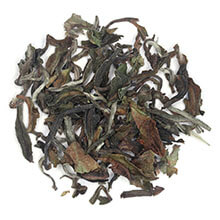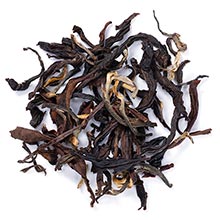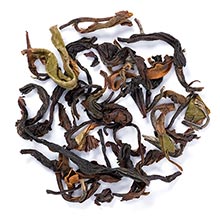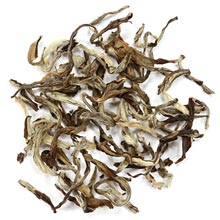Darjeeling Tea: First Flush, Second Flush, Oolong and White Darjeelings
by Janelle Wazorick
April 19, 2022

So, what is Darjeeling?
Darjeeling can be found almost anywhere tea is sold, but what exactly is it? Is it a black tea? Is it an oolong? Is it a white tea? Yes!Darjeeling can refer to any type of tea that is grown in the Darjeeling region of India.
Most of the teas that come out of Darjeeling are black tea, but some of the tea is processed as green, white, or oolong tea.
But no matter the way the tea is processed, unique among Darjeelings is its unique flavor, which can be described as muscatel (or grape-like). Because of their naturally light flavor and nuances, Darjeelings should be enjoyed plain without the addition of milk or sugar.
The tea leaves that will one day become Darjeeling are grown in tea gardens in the mountains of Darjeeling. While many Indian tea plantations grow the Assamica variety of the tea bush (known for their bold, malty flavors), the leaves used to make Darjeeling come from the Sinensis variety, which is often used to produce Chinese teas. As is the case for many fine Chinese teas, tea bushes grown at high altitudes produce smaller leaves than usual, resulting in delicate and smooth teas prized among connoisseurs. Because these tea gardens in the mountains are much smaller than a typical tea plantation at a lower altitude, the tea gardens don't produce a high quantity of tea.
The Four Flushes of Darjeeling
When picking out a Darjeeling, you will no doubt run across the term "flush", which is another word for harvest. There are four main flushes when it comes to Darjeeling teas, each with their own characteristics: First Flush (or Early Spring), Second Flush (or Late Spring), Monsoon Flush (from June or July through October), and Autumn Flush (or Late Autumn). Monsoon Flush Darjeeling is typically used for commercial tea bags and iced tea blends. For a high-quality tea, look for First, Second, or Autumn Flushes (find an Autumnal Flush on the Master's Teas website).First Flush Darjeelings
Considered to be the finest of Darjeeling teas, First Flush Darjeelings are harvested as early as February through April.Because they spend all winter developing, the leaves are packed full of nutrients. A good rule of thumb when picking out a First Flush Darjeeling is that the earlier the harvest, the better the flavor. While black teas are typically fully oxidized, First Flush Darjeelings are less oxidized, making them closer to an oolong than a black tea (though still classified as a black tea). Because of this, the leaves may even appear green. These tea leaves are delicate and lightweight, meaning you might need to use more than a teaspoon to brew a single cup (if you can, weigh the leaves to get the perfect amount). While the resulting beverage might have some astringency, it will still taste fresh and floral.

For a great First Flush Tea, check out Adagio's Spring Darjeeling. This tea comes from the Balasun Estate which has been producing tea since 1871. It has the green color characteristic of a First Flush Darjeeling and produces a light, delicate cup. Let its floral aromas and flavors delight you during your next tea time.
Brewing Instructions: You can brew First Flush Darjeelings like any black tea by steeping the tea in 212°F water for 2-3 minutes. Alternatively, you can brew it like a white tea in 180°F water for 3 minutes. It all comes down to personal flavor preference- try both to see what you enjoy!
Second Flush Darjeelings
While First Flush is generally considered to be the finest Darjeeling, there are many tea drinkers that prefer the bolder flavors of Second Flush Darjeelings. After the First Flush leaves are harvested, new leaves grow rapidly, producing large leaves over a short period of time. These leaves are processed into Second Flush Darjeelings, which are darker than First Flush Darjeelings and have a purplish hue and sometimes light color tips or buds. These leaves produce a stronger, less astringent cup and have a distinct fruity flavor and smooth finish.
Ready to try a bold cup of Second Flush Darjeeling? Adagio offers two Second Flush Darjeelings: Darjeeling Puttabong Summer and Darjeeling Sungma Summer from the Puttabong and Sungma tea estates. Both teas will produce a sweet, warm cup that is great for an afternoon pick-me-up.
Brewing Instructions: Brew a cup of Second Flush Darjeeling at 212°F for 3-5 minutes. Additionally, you can brew this tea at 190-200°F for the same amount of time. Can be steeped two times with a longer steeping time for any reinfusion.
Darjeeling Oolong

Adagio's Ooooh Darjeeling brings this rare tea from the Singbulli Estate to the forefront. This is a great tea for both Oolong and Darjeeling lovers: it will deepen your appreciation for favorite type of tea as well as gain an appreciation for another type. Truly the best of both worlds.
Brewing Instructions: Brew this tea at 212 for 3-4 minutes. This tea can also be brewed slightly under boiling at around 200°F for the same amount of time.
White Darjeeling

If you love white tea, be sure to sample Adagio's White Darjeeling. This lovely tea is a quiet, subtle tea and a pleasant way to spend a relaxing afternoon. Both fruity and floral, this tea is a great way to explore a different take on both white tea and Darjeeling.
Brewing Instructions: While most Darjeelings are brewed like a black tea, White Darjeeling should be brewed as a white tea at 195°F for about 3 minutes.
Some Darjeelings may be out of stock at the moment, but fresh, new batches will be in stock soon! If you are looking to be notified when it becomes available, please follow these instructions: visit the product page and click on the "NOTIFY ME" button, you will receive an email when that product is available for purchase. Or, you may pre-order with free shipping the moment they are available!